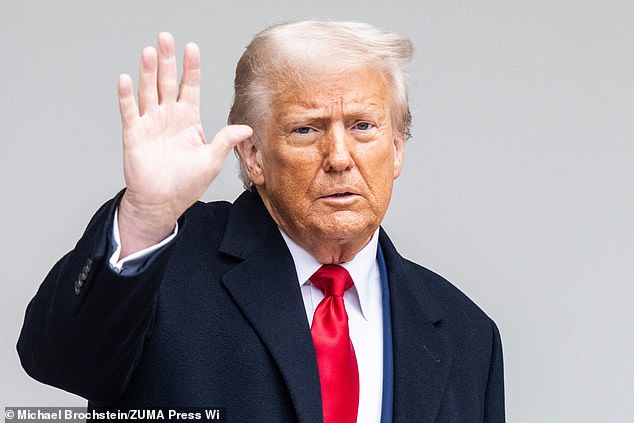- Trump will levy 10% on imports, but what do we charge for incoming US goods?
Donald Trump’s liberation day has sparked panic across financial markets as investors weigh the implications of fresh tariffs for the global economy.
The US President said his ‘reciprocal’ tariffs will kickstart a new golden age of US industry, as he slammed ‘unfair’ levies currently imposed on his country’s exports.
Trump wants to reverse the US’s claimed massive trade deficits with other countries, whereby he says America imports far more than it exports to them.
Britain, with which the US runs a trade surplus, got away relatively lightly with new tariffs of 10 per cent.
But what tariffs does Britain currently apply to goods imports? And how does it affect the US, where around 10 per cent of imports to the UK come from?
We answer some of the key questions.

‘Liberation Day’: Trump has announced tariffs of 10% on imports to the US from the UK – but what goods travel the other way, and what tariffs do we charge the US?
Do the UK and US have a trade deal?
From Australia to Zimabwe, the UK currently has trade agreements in place with dozens of countries around the world.
However, despite much diplomatic back and forth since Britain’s exit from the EU, no such agreement has been achieved with the US.
US exporters are therefore subject to variable levies on a wide sections of goods and services.
What tariffs are charged on US imports?
Broadly speaking, imports face general tariffs, while special levies are applied to certain goods like machinery and transport equipment, chemicals, and materials.
HMRC will also collect customs duties when goods enter the UK.
For example, under the classification of meat of bovine animals, fresh or chilled, a so-called ‘third-country’ like the US imports face a 12 per cent plus £147 levy for every 100kg of beef sold to the UK. An average cow would yield about 225 kilograms of beef, so that would add 12 per cent to the price plus £330.75.
Denim jeans – an iconic US export – face an 8 per cent import tariff as well as 20 per cent VAT.
The UK also imposes a 10 per cent levy on importing most types of cars – well short of Trump’s 25 per cent tariffs.
> You can look up UK tariffs on other countries at Gov.uk
Who pays tariffs?
These tariffs imposed by the UK are passed on to British consumers, as they are paid by the company importing the goods.
VAT – which has also attracted the ire of the White House – is not a tariff.
It is charged where the ultimate consumer is in the UK, regardless of where the seller might be.
It is a sales tax that applies once in the final sale to the consumer.

Donald Trump’s board revealed tariffs he says the US is charged and what it will charge back
DIY INVESTING PLATFORMS

AJ Bell

AJ Bell
Easy investing and ready-made portfolios

Hargreaves Lansdown

Hargreaves Lansdown
Free fund dealing and investment ideas

interactive investor

interactive investor
Flat-fee investing from £4.99 per month

Saxo

Saxo
Get £200 back in trading fees
Trading 212
Trading 212
Free dealing and no account fee
Affiliate links: If you take out a product This is Money may earn a commission. These deals are chosen by our editorial team, as we think they are worth highlighting. This does not affect our editorial independence.
This article was originally published by a www.dailymail.co.uk . Read the Original article here. .


